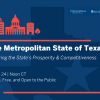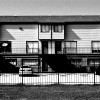
Workshop: 2020 State of Housing in Harris County and Houston
This workshop shares findings from the Kinder Institute's 2020 State of Housing report. Panelists also discuss the current housing situation in Houston during COVID-19

Workshop: 2020 State of Housing in Harris County and Houston
This workshop shares findings from the Kinder Institute's 2020 State of Housing report. Panelists also discuss the current housing situation in Houston during COVID-19

The Urban Sun Belt: Setting The Agenda
This webinar explores findings from a report from the Kinder Institute on the urban Sun Belt – covering such topics as demographic change, the economy, housing, and sprawl. A panel discussion follows the presentation

The Metropolitan State of Texas: Securing the State's Prosperity and Competitiveness
The LBJ Urban Lab at The University of Texas at Austin, the Kinder Institute for Urban Research at Rice University and the George W. Bush Institute-SMU Economic Growth Initiative convened the state's top urban policy researchers for a summit addressing the most important issues in Texas cities: economic development, land use, housing, infrastructure and transportation.

Urban Reads: Elizabeth Korver-Glenn
Elizabeth Korver-Glenn discusses her book, "Race Brokers: Housing Markets and Segregation in 21st Century Urban America."

Home appraisals have long been a source of racial disparity. A new federal effort could change that.
Racial inequities have long plagued the U.S. housing market. Yet only recently has the federal government moved to address one aspect of the real estate industry that continues to exacerbate the racial wealth gap in housing: appraisals.

Efforts to preserve affordable housing must be mindful of transit, quality and flood risk
A recent Kinder Institute report discussed strategies for preserving affordable housing, particularly Harris County’s vast supply of so-called “naturally affordable” units. But knowing which properties should be preserved is a challenge, and the resources committed to preservation tend to be very limited.

With Robins Landing, Habitat for Humanity takes on a new role: master-planned community developer
City officials, home builders and affordable housing developers gathered in northeast Houston this week to celebrate a new model for mixed-income housing.

Sociologist Rachel T. Kimbro discusses her new book, “In Too Deep: Class and Mothering in a Flooded Community.”

Houston’s newest housing development is big on neighborly ties
During the February freeze last year, stories of neighbor helping neighbor were easy to find. Residents with electricity offered up extension cords to charge phones, lent out gas generators to keep heaters going, delivered hot cocoa to keep their spirits up, or simply opened their homes for a few hours or a few days to provide shelter. But what if we didn’t wait until the next disaster to really know and help our neighbors?

A new book, “In Too Deep” tells the story of Bayou Oaks, and its repetitive flooding, from the perspective of 36 mothers who are raising young children there. It follows the families across the course of more than a year, starting right after Hurricane Harvey flooded their homes, and tracking them across the recovery year and beyond as they work to restore their community for the third time in three years.

Houston hopes more homeowners will embrace housing literally in their backyard
There is a lot to like about accessory dwelling units—garage apartments, in-law cottages, granny flats—as a form of housing. Done well, ADUs can help meet the needs for multigenerational families, workers and students, and they offer a gentler form of infill density in urban neighborhoods. They can also provide a source of income and build wealth for the homeowners who choose to build them. What will it take to spark a “backyard revolution” in Houston?
Is 3D printing ready to help meet the demand for housing? Texas puts it to the test
The urban population centers in Texas are losing their competitive edge in terms of housing costs, and it's becoming more expensive to build houses everywhere. Could 3D-printed housing help cities keep pace with demand and keep costs under control? One of the largest tests of the technology will soon be underway.

How close is Houston to ending homelessness? Closer than you think.
Houston has made considerable progress in reducing homelessness in the past decade. We know exactly what it will take to become the first major city to effectively end homelessness—including how many affordable housing units we’ll need to build.

Zillow, other iBuyer algorithms appear to be fixated on Harris County’s suburbs
Zillow’s recent high-profile offloading of its properties drew attention to the relatively new “iBuyer” sector of the housing economy. In this blog post, I explain this sector and map the location of Zillow and other iBuyer properties within Harris County. My analysis suggests that while urbanists often mull over gentrification, and this Institute often researches the subject, it doesn’t seem to apply to what’s happening to the communities where speculative investors operate.

How Harris County can keep its affordable housing from falling out of reach
Any attempt by Houston or Harris County to build new affordable housing will be for naught if thousands of existing units become unaffordable along the way. The Kinder Institute’s Housing Preservation in Harris County report examines the state of both forms of housing in hopes of identifying how the community can keep housing accessible to its working class residents.
Rice University
Kraft Hall
6100 Main Street, Suite 305
Houston, TX 77005-1892